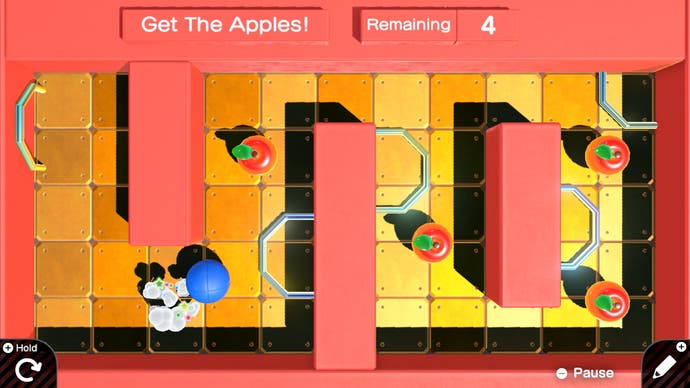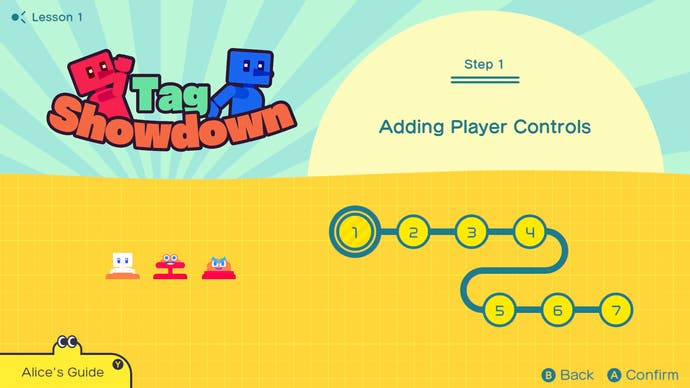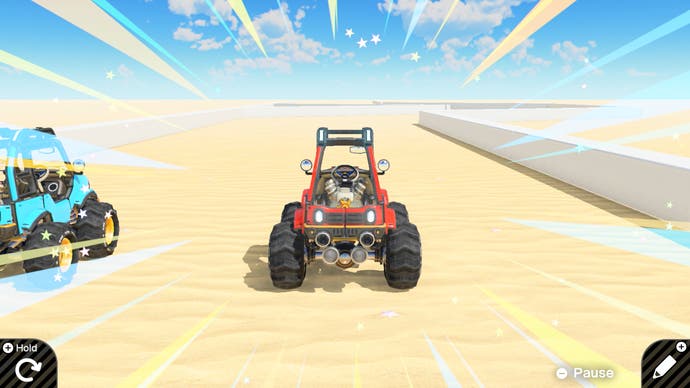Game Builder Garage promises a Nintendo masterclass in creativity
Meet the Nodons.
Nodon. I'm sorry? Nodon. Not Monad. Nodon. Funny word - a palindrome, which is always money in the bank. I picture a sort of spring, for some reason, a springy, chewy, bouncy thing, each side contracting inwards to that central D, that pivot. Nodon is a brilliant word. It sounds like the sort of thing you might have filling a useful drawer somewhere in the back of the shed. "Could you get me the portable hot-plate? It's next to the Nodons." It sounds like the ambassador from an alien race who has already promised to help with our whole carbon emissions thing. All considered, I hope whoever came up with Nodon got a day off in lieu.
Nodon is one of the stars of Nintendo's new game. Or rather Nodon are, because they are many. Nodon are legion. "There's a Nodon for that," you might say, reaching for some ludic variation of that drawer in the shed. Quite. There probably is a Nodon for that. The other star is you, because Nintendo's new game is not a game at all, really, but rather a tool for making games. There are plenty of these tools, right, and yes, Nintendo has made a few. It's made a few game-making tools that were pretty much games in themselves actually. And now it's made another. And this one comes with Nodons in it.
Game Builder Garage will be exclusive to the eShop when it launches on the 11th of June. It's a selection of tools for making games. Any kind of games! Test it! And it's built around seven lessons. Each lesson teaches you how to make a specific game in a specific genre. The lessons promise to be funny, and playful, and they will build on one another. After the first lesson is done, though, you'll unlock a mode that allows you to freely create, so you won't be constrained by the lessons or their genres for long.
Though I doubt they will be constraining anyway. This is probably where a lot of people are going to have a very reverent kind of fun. Game-making lessons from Nintendo! A glimpse inside the Mario machine. The lessons will encourage you to make your own decisions when following the instructions. So we all do the same lessons but your games look very different from mine at the end of it. (Mine probably doesn't work, for starters.)

What kinds of games can you make? Shooters, platformers, side-scrollers. 3D games, first-person games, strategy games. Puzzle games. Music games. Any kinds of games. The trailer suggests the possibilities are very broad. Test it.
And there seem to be two principles driving everything. One is the drawing of lines. You have a controller input, the trigger, say, and you draw a line from that to instructions: shoot, or jump, or duck, or whatever. And once that's done the trigger allows you to shoot or jump or duck or whatever. Drawing lines between things connects them, as any detective a week away from retirement would tell you. In Garage, it makes them work together. An idea so simple it's no surprise it came from the people who employed a graph paper aesthetic to make their Mario editor work.

Connect lines between game ideas, cause and effect, pieces of the UI and all that jazz. That's one part of it. The other is the Nodons. As I understand it the Nodons are game concepts and general bits of business. So a thumbstick is a Nodon - connect it to decide what it does. But there's also a Nodon for spinning things - connect it to a platform and it will spin. There's a timer Nodon, a sound effects Nodon, a texture Nodon - use the Nodon to draw a texture and then anything you connect to it will also have that texture.
Sharing your creations sounds very Nintendo, I'm afraid. No browser, but once you've uploaded your first game you get a Game ID and a Programmer ID that you can share with people. On the plus side, the game supports four control methods - buttons and sticks, touch, motion sensing when docked, and you can also plug a USB mouse into the dock. That mouse is just for programming, though, not for playing.

I watched all this and I thought, this is all great isn't it? Gosh, Nintendo are the masters of making complicated things simple, but without sacrificing any of the potential depth. And I rolled the word Nodon around and decided I quite liked it. But I also thought: there is the basis of a powerful accessibility tool here, with the easy remapping of inputs, with the variety of ways to control the programming. I hope this is the start of something - for players and Nodons, sure, but also for the ways that Nintendo allows players to interact with its games in general. A Nodon layer on the Switch interface? I'd give everyone a day off in lieu for that.



